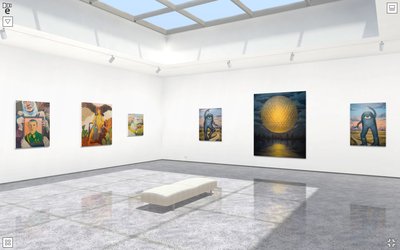
Discover how your 3D virtual gallery gives you more opportunities to grow your audience and create long-term engagement.
Every exhibition is an opportunity to introduce your audience to new artists and new works. That goes without saying. But talented gallerists know how to set the scene for an even bigger success.
It’s standard practice in the art world for galleries to present exhibitions on a monthly roster. That limits them to around 12 shows per year.
With Exhibbit you can plan ahead. You can curate multiple exhibitions and even publish them with future dates to automatically launch over each other on the due date every month. If the gallery is embedded in your website it will update automatically every time a new exhibition is published.
Your virtual gallery is naturally a great deal quicker to curate than a bricks-and-mortar space. If you are well prepared with your images and have all the information ready, a show can be published to the web in just a few hours.
You can generate buzz by posting a 3D preview of your exhibition with selected works from the exhibition the week before opening night. To gauge interest in specific works before the show opens, include the option for people to Like or Vote for their favourite artwork.
You can turn this into an exclusive invite by setting a password for entry, and allowing people to pre-purchase directly from the virtual gallery preview.
When you have a large number of art works to show, it can be easier for viewers to discover them if you divide the exhibition into several smaller shows. Then launch a new part of your show on successive weeks or months.
You’ll need to be careful not to overdo the frequency, but a staggered release campaign can generate strong interest if you engage with your audience, let them know what you are doing and why. Each new launch is an opportunity to send out invitations and grow your followers.
Send your prospective audience an invitation to view selected works from the upcoming exhibition in the 3D gallery. You could also turn this opportunity into an exclusive invite by setting a password for entry, and allowing people to pre-purchase from the preview.
Another method worth considering when you have a large amount of art work to display is to divide the exhibition into several smaller shows, launching a new part of the show each week or month. This will give each artwork more physical space, so they can be viewed in isolation.
You’ll need to be careful about the frequency, but it could generate good interest if you create a campaign around it by letting your audience know what you doing and why. Each new exhibition launch is an opportunity to send out new invitations. They’ll come onboard and follow you and your journey.
Give viewers the opportunity to see a record of your shows online. Then they can understand the scope and quality of art that comes through your doors, and mentally bookmark your gallery as a place worth coming back to.

Images showing views of the installation can be added to your website as each exhibition closes. This is easily done by taking screenshots of different views around the virtual gallery. Recording past exhibitions in this way provides the important provenance prospective collectors will seek, because they’re able to view the artworks in a past exhibition and establish what price they sold for.
These are all solid reasons for your audience to keep coming back, not only to experience new exhibitions, but also to review archived shows by artists whom they may have recently discovered.
They can choose and purchase artworks with confidence that they have good-quality background knowledge. Good for the artist, good for the collector - and good for the gallerist.